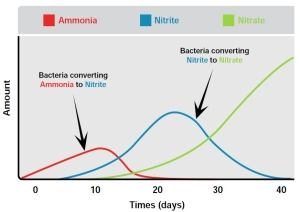Starting an Aquaponic System
Aquaponic System Cycling
Starting an Aquaponic System is often called system cycling. Under normal conditions, the process of cycling takes 3-5 weeks until a bacterial colony is established. However this process can be sped up using liquid nitrifying bacteria. The cycling process involves introducing ammonia and nitrite to the aquaponic system, and progress is measured by monitoring nitrogen levels.
Aquaponics Start Up Procedure
Put simply, the recommended method of starting the system is:
- Connect all components of the system, and add clay pebbles to your grow bed. Rinse the clay pebbles thoroughly before adding them to reduce the red dust washed into your fish tank.
- Add water to fill the fish tank up to 5cm of the rim. Use chlorine neutraliser at the regular concentration if tap water is used.
- Leave the system overnight or longer to check there are no leaks and the syphon (drainage) system is working correctly.
- Plant seedlings when you are satisfied with the systems operation. At this stage you may wish to add supplements to help the plants grow including:
- Bloom Cal/Mag - a cost effective and basic nutrient for plants that includes nitrogen, iron, calcium and magnesium
OR a combination of
- Micronutrients from kelp using Bloom Seaweed or Seasol Powerfeed
- DTPA Iron chelate
- GT Trace elements
- Potassium Bicarbonate
Optionally you may wish to add beneficial bacteria to speed up the cycling process, such as PondPro Filter Start.
- Continue to add water to the system if there is evaporation. Using a chlorine neutraliser (or letting the water sit for 24-48hours) will ensure new tap water doesn't kill off the bacteria population.
- Continue to test ammonia and nitrogen levels, and within 3 ? 6 weeks the nitrification process will have completed and fish may be added safely.
- Continue testing and pump out water if ammonia or nitrite levels go to high, replacing with fresh water.
Preparing an Aquaponics Tank for Fish
When preparing a tank for fish, aquaponics water testing is performed to ensure water quality is suitable for adding fish. The API Freshwater Master Test Kit contains simple to use ammonia, nitrite, nitrate and pH tests. The levels of ammonia and nitrite need to be zero (or very close) before adding fish, and the pH should generally be below 7.5 (depending on the fish you choose). When filling the tank with tap water, a chlorine neutraliser such as PondStart needs to be added to remove chlorine, as chlorine is toxic to beneficial bacteria.
Sources of Ammonia When Starting an Aquaponic system
Ammonia can be sourced from plant nutrients (hydroponic), pure ammonia from the supermarket, or via adding fish to the system before the bacteria are established. Using a simple hydroponic nutrient you can get your plants growing quickly and healthily, along with adding other useful nutrients to the system. We recommend Bloom Cal for this purpose. When using household ammonia, check that the product is 100% ammonia and doesn't include other fragrances or chemicals that could affect the system. Using fish is also a great option, but read on to check our suggested stocking density.
Creating the bio filter
Part of the Aquaponic system start up procedure is creating a bacteria colony. This nitrifying bacteria will establish itself within 5-6 weeks with no other intevention. However, to get the process started quickly (within a week) beneficial bacteria such as Bio-starter can be added. With such nitrifying bacteria, a healthy biological environment is created that supports the bacteria, fish and plants.
Adding fish to an Aquaponics System
Fish may be added to a system during the establishment of the bio filter, but it is much safer to add them after the nitrifying bacteria are established. When fish are added before the cycling process is completed they are a source (or another source) of ammonia for system cycling. Fish that are added early will suffer the effects of high ammonia and nitrite levels through the cycling process, and it is common to lose some of the fish. If you choose to use fish during the cycling process, add less than 500g of fish per 1000L to reduce the ammonia and nitrite spikes.

If you choose to wait to add fish, ammonia and nitrite levels may be monitored to check the cycling progress. Only when ammonia and/or nitrite are low or zero it is safe to add fish. Nitrate is far less toxic to aquaponic fish than ammonia and nitrite, however if nitrate exceeds 160ppm fish may have a decreased appetite and activity. If ammonia, nitrite and nitrate are very high, a half water exchange will reduce these parameters by half. If these high levels persist, more filtration and plants are needed to convert and absorb these nutrients.
After the nitrogen cycle is established
Sometimes ammonia and nitrite can increase due to filter or grow bed cleaning. If tap water is used to clean the filter or grow bed, the chlorine present in tap water will kill beneficial bacteria. If rain water is used, the difference in pH and temperature can also affect beneficial bacteria. To prevent this from happening, always the clean filter and grow bed media with water from the aquaponic system.
Keep the system clean
Uneaten fish food left in the system for more than a day will cause ammonia and nitrite to increase. There is also the chance of dangerous bacteria building up with uneaten food left in the system too long. Sludge buildup on the base of the fish tank, filters and grow bed will also increase the levels of ammonia, nitrites and nitrates in an aquaponic system. Use an aquarium siphon or a small pond vacuum (or pond sucker) to clean the tank, and check any bell siphons regularly to see if they are draining the grow bed as much as possible.
